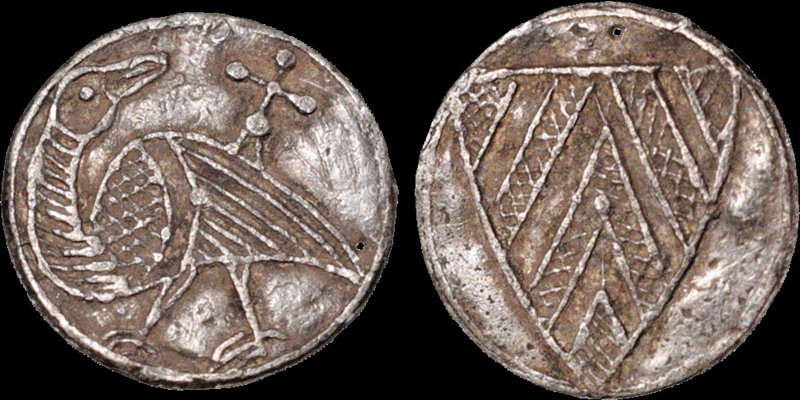LATEST PURCHASE - England’s First Trade Tokens? Anybody can assist?
 petitioncrown
Posts: 62 ✭✭✭
petitioncrown
Posts: 62 ✭✭✭
When did the use of trade tokens in Britain begin? The answer may be during the reign of Edward I whose introduction of a round farthing in 1279 quickly put an end to the need for a token to use as “small change.”
Thirteenth Century Britain. Pewter token. .72 gm. 16 mm. A bird (goose? though the authors cited call it a pelican) walking left, head turned back, a cross with pellets at the tips above / A square topped shield with alternating bands in an inverted V configuration. As 7a, plate in Num Chron VIII (1845-6); pp 116ff. Cf. SNC LXXIX (1971); pp 446ff. Good Very Fine.
Why a pelican when it looks like a goose? It has been considered a symbol of Christ because of the legend it would use its beak to cut itself to obtain blood to feed its young--an example of self sacrifice.

The story begins in the 1845-6 edition of the Numismatic Chronicle with the report of a find of “several hundreds” of “quaint” tokens found in a ditching project just outside the great London wall near Aldersgate Street, a location not far from the Museum of London.
Their article is rich with detail: Who? Probably ecclesiastical (“1307 marks the first recorded citations of English secular pewterers in London.”) They do not pin down an exact use leaving room for the token speculation. How made? Stone molds. Why pewter? More durable than lead. Designs? Decorative rather than informative. The authors also provide extensive lists of varieties and die combinations.
These high quality cast tin tokens were first discovered in the early 1840s in a ditching project not far from the Museum of London. At the time, John Akerman, an important 19th century numismatist commented about the perennial need for small change suggesting that may have been why these were made. Though subsequent scholars have agreed on the 13th century date and the fact that these pieces did have a “numismatic” purpose, it remains an interesting puzzle whether these were made for ecclesiastical or trade purposes (or both).
The Worlds Most Prestigious and Valuable Silver Coin. Thomas Simon and two Kings of Numismatics together Petition Crown & 1804 $
Comments
I have seen them in Allan Davisson's auctions from time to time, but I have never managed to snap one up. I quite frankly believe they are ecclesiastical issues in some way - perhaps even an early form of communion token.
Very occasionally "Boy Bishop" tokens can be found by detectorists, they are quite scarce. Basically it was a religious ceremony with the aim of getting young males interested in the church as a career - so they had a specific day of the year where a boy was chosen to be the Bishop for the day. At the end of the ceremony it is conjectured that he was then given a token that could be redeemed for foodstuff's etc.